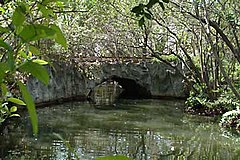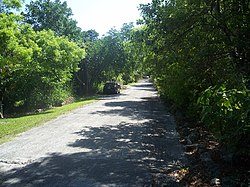Arch Creek, Florida
| Arch Creek Park | |
|---|---|

Arch Creek natural limestone bridge was the site of early settlement in Miami-Dade county
|
|
| Type | Municipal |
| Location | Miami, Miami-Dade County, Florida, United States |
| Area | 8 acres (32,000 m2) |
| Created | 1982 |
| Operated by | Miami-Dade County Parks and Recreation Department |
| Website | Arch Creek Park |
|
Arch Creek Historic and Archeological Site
|
|
 |
|
| Location | Miami, Miami-Dade County, Florida, USA |
| Nearest city | North Miami, Florida |
| Coordinates | 25°54′04″N 80°09′41″W / 25.90111°N 80.16139°WCoordinates: 25°54′04″N 80°09′41″W / 25.90111°N 80.16139°W |
| NRHP Reference # | 86001700 |
| Added to NRHP | July 15, 1986 |
Arch Creek was an early settlement in Miami-Dade County, Florida, in present-day metropolitan Miami. Tequesta Indians thrived here before the first Europeans arrived in the early 16th century. The name is derived from the natural limestone bridge spanning 40 feet (12 m) across the creek. It is part of the Arch Creek Memorial Park at 1855 Northeast 135th Street, on Biscayne Boulevard. It was added to the U.S. National Register of Historic Places on July 15, 1986.
During the Seminole Wars, General Abner Doubleday (often credited with inventing baseball) blazed a trail between Fort Lauderdale and Fort Dallas on the Miami River. This Military Trail crossed over the limestone bridge, traversing the fresh water creek flowing from the Everglades to Biscayne Bay. In 1895, Henry Flagler's railroad reached Arch Creek as it expanded southward, bringing a steady stream of visitors and settlers, largely from east coast states.
The first families to settle the area planted tomatoes and pineapples. A railroad depot was established in 1903. Soon after, a packing plant, a sawmill, a post office and a school were erected as the town began to grow. By 1910, the area was a popular place for tourists and community gatherings. The "shell house" sold souvenirs, postcards and refreshments. On weekends, families from many miles away would attend barbecues with as many as 500 people. "Dad" Wiggins, the self-proclaimed best barbecue chef in Florida, would start slow-cooking large amounts of meat and families would bring baked goods, side dishes and desserts while kids played along the banks of the creek. By 1912, the community included eighteen homes, a church, a general store, a blacksmith shop, and two tomato packing houses.
...
Wikipedia



